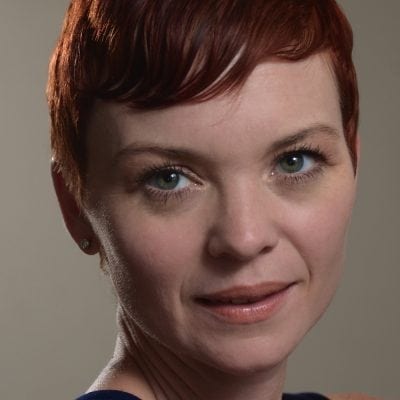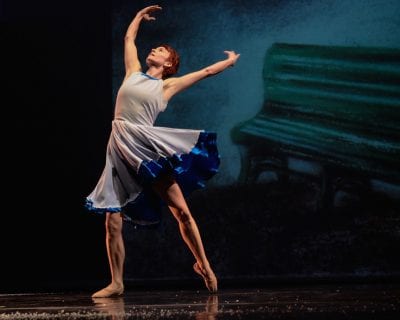A Conversation with Guest Editor Helen Hansen French, Part One
by DANNY OLDA | October 25, 2018

Choreographer and dancer Helen Hansen French is a force, in motion and with a momentum at her back. Watching her perform as a dancer, this characteristic is as clear as it is literal. However, it extends into her work in the dance and larger arts communities as an advocate for the artform and a catalyst for new projects and collaborations.
Speaking with French several times over the course of a month, she was generous with her time though, as you’d expect, she has little of it. Among many projects and performances in the wings (including a pair of upcoming performances for the Creative Pinellas 2018 Arts Annual), French was preparing for St. Pete Shares the Stage!, a series of performances bringing some of the best dancers and companies from throughout the region to a single stage in conjunction with SPF 18, the St. Petersburg Festival of the Arts.
Though born in St. Petersburg, Florida, French received her education and has performed nationally and internationally. She attended and earned her Bachelor Fine Arts degree from the Julliard School and has performed in numerous venues and festivals such as Rishon LeZion International Festival in Israel and the Oriente Occidente Festival in Rovereto, Italy. She is once again living and working Pinellas county.
In our conversation it became clear that Helen has given a lot of thought about her craft as well as her intentions and aspirations behind it. In this first part of two, we speak about her journey to making dance a career, the support she’s received, the idea of dance as a means of communication between the artist and the audience as well as the artist and herself.
DO: So, I usually like to start right from the beginning. I’m fascinated by a transition a lot of artists make from their craft being an early passion to taking it seriously as a career choice. When did you begin to love dancing and how did that turn into a serious option for an actual career?
HF: Some of the earliest memories of my childhood involve moving and music, playing the piano at my grandparent’s house, making up compositions and trying to dance them when I was very young, then getting enrolled into ballet classes. I think it was the summer after kindergarten that my mom put me into dance classes. I was pretty young when I really began to love the language of movement and dancing. I would say by the time I was 13, that summer I went to Pittsburgh Ballet Theatre’s summer intensive program and that’s a six-week immersion, intensive, four dance classes a day. I was away from home, I lived on a college campus in Pittsburgh. The company was also rehearsing and teaching our classes. That’s when I began to see that dancing was really a profession, that you could be around people that went to work every day and this is what they did.

By the time I had that experience and I think realized I was good, that this is something that might actually be possible for me. I had pretty much decided at that point that this is what I’m going to do. At that age I thought, with what I’ve been exposed to and what I thought was possible, that I was going to be a ballerina. Then, the older I got and the more things I was introduced to, I started to be drawn to other styles of dance as well as other ways of communicating. I had African Dance when I was at Gibbs High School, PCCA [Pinellas County Center for the Arts] and I was exposed to different modern styles.
“I didn’t know exactly how, but it was pretty clear that I was going to have a life lived in dance. That was going to be me.”
I think of dance as a language and that’s become even more clear to me the older I get. I’d say movement is my first language. I think it probably is for every child. It is a vehicle of communication that I find extremely fulfilling. So, I think when I began to see that as a teenager I thought, “I could really do that. I just need to get a broader vocabulary.” By the time I was accepted at the HARID Conservatory for a year and then went into Julliard, I knew this is what I was going to do. I didn’t know exactly how, but it was pretty clear that I was going to have a life lived in dance. That was going to be me.
Speaking to a number of artists, they’ve often expressed the idea that, as a young person, we’re often either given permission to be an artist or we’re not given permission. Did you find as you were growing up, a lot of support from people closest to you to pursue an artistic career or, or was it a struggle to convince them it’s a viable choice.
I think I’m a rare breed that has an extremely supportive family. My mom is a retired school teacher, taught gifted, and she never told me not to do it. And, in fact, I got more than encouraged. You go through ebbs and flows and things get hard and you’re a teenager and you get kind of grumpy. My mom would just always say, “You know what? Stick with it. You’ll get past it.”
I think for me, I always knew I had that support. I remember being really floored when I was at Juilliard and a few of my classmates would say, “My parents don’t understand why I need to get a degree in dance. They wanted me to go to school so I can have something to fall back on.” That was the first time I was really introduced to a “fall back on” idea which was also confusing to me. I didn’t have a parental set-up that said this is a hobby, this is just something you do for fun. It was very clear that this is what I love to do and I think my parents were supportive. My brothers made fun of me because they’re my brothers and that’s what they’re supposed to do. But I think as I’ve gotten older and we’ve all matured I think they see it, that it’s an actual valid occupation. Which I think is rare. I don’t think my story necessarily describes the majority of people in any kind of art field, but I think that says more about our society and the culture we live in then about me personally. I don’t think we embrace the arts as much as we could as a nation.
Yeah, it’s definitely telling us something much bigger.
Yeah, and I think that in St. Pete particularly as a child there were plenty of opportunities to get a dance education. That was never really lacking. It’s the next step, the professional aspect of it that I feel we’re really starting to build here in St. Pete and Pinellas county.
Earlier you mentioned you felt like dance was like a language. I’m by no means an expert in dance at all. However, I do feel like, and it was reemphasized to me at the last performance I’ve attended, that when I watch a dance performance I feel a lot more like I’m reading something rather than looking at a piece of visual art and I can’t explain why that is.
I think it’s interesting you equate it to reading because it’s so incredibly visual but I think it is maybe similar to decoding. For example, what are they trying to do up there? Or how are they using space to say something? I don’t like the word emoting, but what are they emotionally trying to convey?
This goes into my creative process and how I personally create work or develop characters for work that I’m doing. There’s always an inner dialogue going on about who am I talking to or who am I trying to communicate with or who is the work for. It’s always for me, but who am I in communication with? Is it the audience at large, is it my community, is it a subset of my community, is it my children, is it God? I think that question is always there for me. And when I build a movement it has to have that inner connection narratively in order to feel fully fulfilled. I can do movement, I can take a class and connect to the music and do the right steps, but there has to be another layer that makes it personal. I think a lot of artists have an inner dialogue continuously going. I think that instinctively begins to happen for artists as they begin to have their own voice and for me it just comes out in movement.
The hard part I think is keeping that conversation alive in repertoires you do 100 times. I’ve performed Jacqulyn Buglisi’s Requiem maybe 50 to 75 times. I’ve performed it extensively. How do you keep that new each time? That’s where it gets really interesting about the idea of communication. Because no one has the same conversation twice. Have you ever noticed if you’re having a conversation with a friend and its literally the same conversation you had last week it feels frustrating or inauthentic? So how do you have that new conversation each time with a piece or a work? I think it’s maybe unique to performing artists, whereas when a painting is painted or a poem is written down it’s done, while in dance there’s a constant renewing of that conversation.


